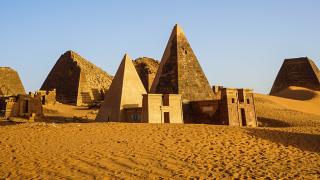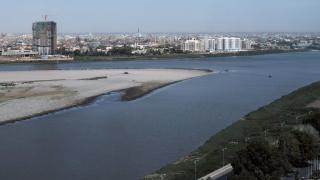5 Things to Know About Sudan
5 Things to Know About Sudan
Exploring Sudan: A Tapestry of Culture, History and Resilience
Sudan has suffered long-term political instability and economic pressures. Now, the year-long war has exacerbated people's needs and left almost 25 million – more than half of Sudan’s population – in crisis. More than 10 million people have been displaced, with 1.5 million fleeing to neighbouring countries.
But as so many people are uprooted from their homes and forced to leave their land, they carry a rich culture and heritage with them. While we raise awareness of the war that wages on there and the voices of Sudanese women suffering, we must also keep the richness of this country alive.
Sudan is one of the largest countries in Africa and it is full of culture, history and resilience.
Here are five facts you may not know about Sudan:

1. More pyramids than Egypt
The ancient Nubian civilisation
Sudan is home to the ancient Nubian civilisation, one of Africa's oldest and most advanced cultures. Flourishing along the banks of the Nile River thousands of years ago, powered by agriculture, the Nubians built magnificent pyramids, temples and palaces. The Kingdom of Kush, a powerful Nubian state, once reigned over vast territories, establishing its capital in cities like Meroë. Today, there are more than 200 pyramids – more than double the number in Egypt, their neighbouring country.
2. Sudan’s Rich Cultural Diversity
Over 500 ethnic groups
Sudan boasts more than 500 distinct ethnic groups, including the Arab, Nubian, Fur and numerous others, and over 400 languages. Each ethnic group brings its unique customs, practices and beliefs, enriching the fabric of Sudanese society.
The Arab population, predominantly found in northern Sudan, makes up around 70% of the country's population and has greatly influenced the country's language, religion and cultural practices. Arabic is widely spoken and serves as the official language of Sudan, while Islam is the predominant religion, shaping many aspects of today’s daily life and societal norms.
Sudan was once part of the powerful Nubian civilisation, thousands of years ago. The Nubian people, who inhabit the Nile River Valley in northern Sudan, have a distinct cultural identity deeply rooted in their ancient heritage. The Nubians are renowned for their vibrant music, intricate handwoven textiles, and unique architectural style characterised by colourful geometric patterns. Festivals such as the "Wakha" celebration, which marks the beginning of the agricultural season, showcase Nubian traditions and folklore, drawing communities together in joyous celebration.
Further south in Darfur, where the current war is particularly dire, the Fur people are renowned for their rich artistic heritage, including intricate woodcarvings, vibrant beadwork, and elaborate pottery. Traditional ceremonies such as the "Mungu" festival, which honours ancestors and celebrates the harvest season, exemplify the deep spiritual connection that the Fur people maintain with the land and their cultural heritage.

3. Shaped by the River Nile
Where the tributaries meet
Often associated with Egypt, the River Nile (the longest river in the world!) courses through the heart of Sudan. Revered as the lifeline of ancient civilisations, the Nile sustains agricultural land along its banks, providing fertile soil for crops and sustaining communities – as it has done for millennia.
The Nile has two main tributaries, the White Nile and the Blue Nile, which merge together in Sudan's capital, Khartoum. For Sudanese people, the Nile holds profound cultural significance, serving as a symbol of abundance, renewal and continuity.
4. Once Africa's largest country
before the birth of South Sudan
Sudan became independent from British colonial rule in 1956. During the First Sudanese Civil War (1955-1972), fighting between the north and south were over demands for more regional autonomy by Sudan's southern region. Conflict then rose again in 1983, with the Second Sudanese Civil War - largely seen as a continuation of past disputes. This is what led to the secession of South Sudan in 2011.
Before Sudan split into two separate countries with the birth of South Sudan, Sudan was Africa's largest country – a title now held by Algeria.

5. Spirit of resilience
holding onto hope
Despite its history of conflict, which continues today, Sudanese people hold onto resilience and hope. From grassroots peace initiatives to community-led development projects, Sudanese people and organisations are working tirelessly to rebuild their lives and nation and to create a brighter future for generations to come.
Since the most recent conflict began on 15th April 2023 we have been supporting partner organisations on the ground through our Conflict Response Fund.


